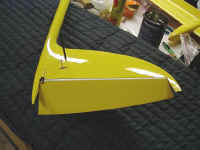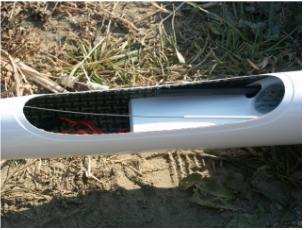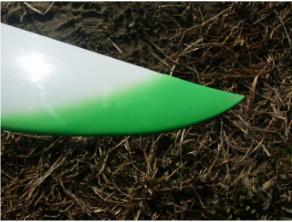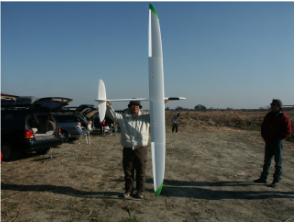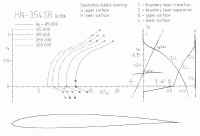
|
Air
foil |
Wing Span | 3,200mm |
| Cord Length |
NA
|
|
| Wing type | HN354SR(Norbert Habe's stable) | |
| Wing Area | 65dm2 | |
| Wing Load | 29.6-61g/dm2 | |
| Structure |
Carbon
D-Box or Full Carbon
|
|
| Portability | 3 pieces | |
|
|
||
|
Tail
plane
|
Tail type | C-Tail, HN315S |
| Tail Area |
6.9dm2
|
|
|
|
||
|
etc.
|
Total Weight | Light
version: 1,950g D-Box version: 2,000g - Ballast :480g Carbon version: 2,300g - Ballast: 1,000g |
| Radio gear |
6
Servos, 7 Channels over
|
|
| Fuselage
Length |
1,490mm | |
- The NYX is a new
molded F3F, F3B, F3J model that should be in production, and in the air,
before the end of the year 2001. These days it can seem as if there are
new mauled models everywhere, but this isn't strictly true. What there
is, is choice,
which didn't exist some years back. Some specialization has taken place
in mauled model design, with F3F and F3J model models beginning to move
more towards particular styles, which are seen as beneficial in those
particular tasks. Designing an
all-rounder is difficult by any stretch of imagination, but succeed, and
you have an F3B model.
- The NYX from Breta model is pitched squarely at F3B/Slippery F3J end
of the market, but even a cursory glance at the model will tell you that
it's going to be a contender in the F3F field as well. It is quite large
by F3F standards, it is told that a 3.0 meters version is being mauled
for dedicated slope use.(Quoted from Quiet
Flight International 53 Oct./Nov. 2001) (see the more comments bellow
in this page)
(Mr. Miyakawa's Comments on 13 January 13, 2002)
NYX has been imported to Japan 29 Dec. 2001, which was the first model that imported to Japan. We asked Mr. Miyakawa to evaluate NYX, who is a excellent F3B competition flier. We could see its maiden flight on 13 January 2002. His first impression on the kit is that the quality or completeness of NYX was more than his expectation. The stiffness of nose is stiff enough comparing with nose corn type fuselage, which enable us to stab at the ground when targeting the landing point precisely. The characteristics of trendy F3B model is the thin and super stiff airfoil such as that of Estrella and Champion A-model. The profile HN354SR is quite similar to the SA series profile adopted by Breta-model so far, and is very thin. Here we can have his report about maiden flight at the bottom of this page by Mr. Miyakawa including comments on the stiffness in the direction of spar of airfoil. The best time of his maiden flight was 16sec for Task C. (He pointed out that airfoil was much warped or deflected while launching in strong against wind and turning quickly in TaskC. However, Breta model treated his comment with quite sincere manner and quickly agreed to make airfoil stiffer. The reinforced airfoil will be provide very soon, from the first quarter of 2002. ) C-tail is very skinny surface rudder and stabilizer, is almost transparent as shown in the following photo. The fuselage is very robust, because it has thick orifice at the root of C-tail. The tortional rigidity seems to be enough to prevent C-tail from twisting at launching and Task C. The most grateful thing is that all wiring has been installed including 9 pin connector at the airfoil and fuselage as shown in the photo. See the following comment as for its detail.
|
Designer
/Manufacturer |
Breta Model(Czech Republic) Jaroslav Hlavko & Martin Rails | |||||||||||||
|
Price/Shop
|
F3X.com
:price:
|
|||||||||||||














